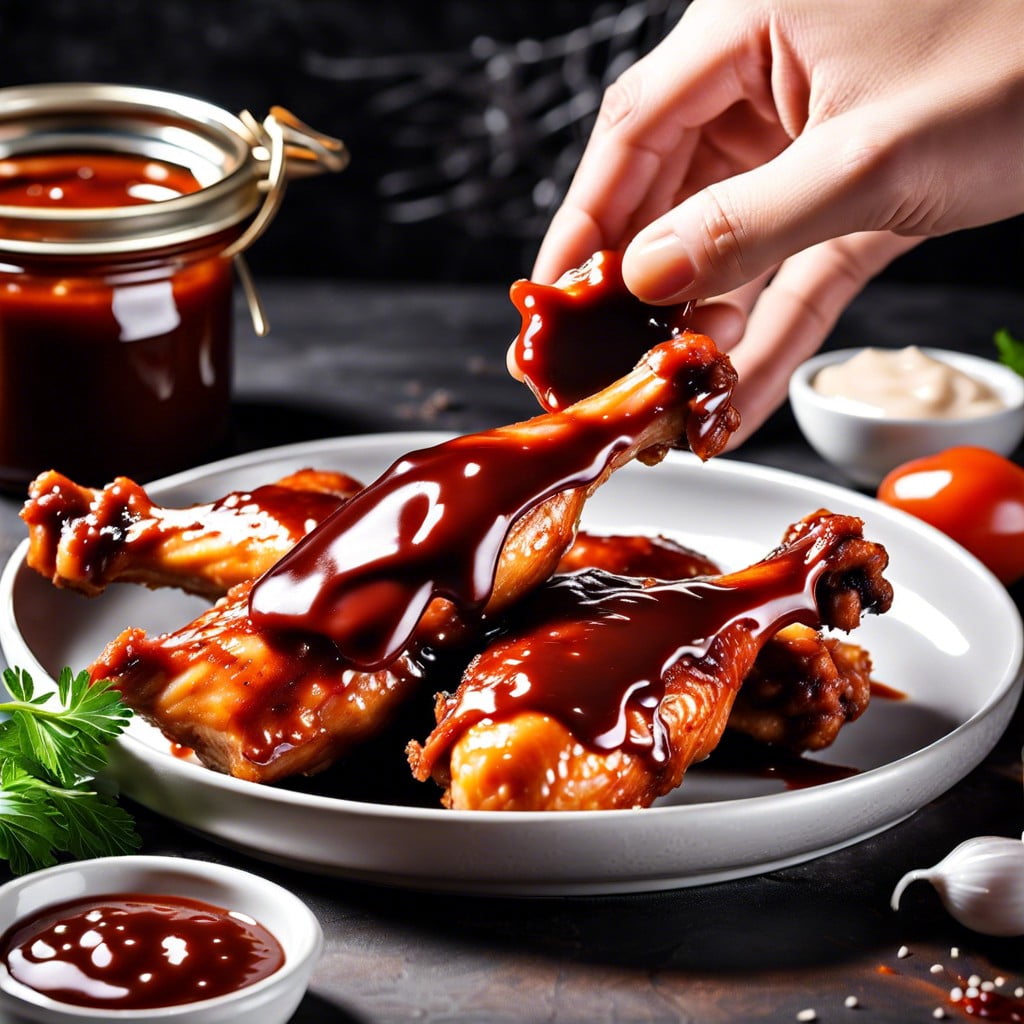In this guide, we’ll clarify the optimal timing for applying BBQ sauce to chicken to enhance flavor and achieve a perfect glaze.
Key takeaways:
- Apply BBQ sauce to chicken during the last 10-15 minutes of grilling.
- Apply BBQ sauce to smoked chicken in the last 30 minutes to 1 hour of cooking.
- Use multiple thin layers of sauce for a richer glaze.
- Dip basting brush lightly in sauce and apply with gentle, even strokes.
- Monitor chicken closely to prevent charring as sauce caramelizes.
Preparing the Chicken

Before considering when to slather on that BBQ sauce, it’s crucial to start with properly prepped poultry. Ensure your chicken is clean, pat dry and, if needed, trimmed of excess fat. This helps in achieving a better sear and also allows spices and rubs to adhere well, forming a flavorful crust.
Opt for a light coating of oil to prevent sticking to the grill and to facilitate even cooking. If employing a dry rub, apply it to the chicken one to two hours beforehand, permitting the flavors to penetrate the meat. With these steps, the chicken is prepped and ready for the grill or smoker, setting the stage for that delectable BBQ sauce to shine later in the cooking process.
Understanding the Cooking Process
Grilling and smoking fundamentally affect the texture and flavor of chicken, with direct high heat providing a quick sear on grills, and low and slow heat enveloping the meat in smoky flavors in smokers. In both methods, meat fibers contract and juices redistribute. The crux of meat preparation lies in maintaining moisture while achieving a safe internal temperature – 165°F as recommended by the USDA for poultry.
Understanding when these changes occur during cooking informs optimal sauce application timing, preventing premature charring or sauce loss, and ensuring the sauce melds with the chicken’s surface to create a delectable, sticky glaze.
Timing for Sauce Application: Grilling Vs. Smoking
In grilling, where high heat cooks food quickly, sauce should be applied during the last 10 to 15 minutes to prevent burning the sugars in the sauce and to ensure a sticky, caramelized coating.
Conversely, smoking involves low and slow cooking. For smoked chicken, consider applying sauce in the last 30 minutes to 1 hour of cooking. This timing allows the meat to absorb the smoky flavors before the sauce forms a flavorful crust on the exterior.
For both methods, avoid early application to prevent premature charring and to allow the chicken’s natural flavors to develop. Multiple thin layers may be preferable to a single thick one, creating a richer glaze without overwhelming the meat’s texture and taste.
Basting Technique for Even Coating
Achieving an even coating of barbecue sauce on chicken is crucial to balance flavor and texture. To start, use a heat-resistant basting brush which can withstand the high temperatures of grilling or smoking. Dip the brush lightly into the sauce, allowing excess to drip off to prevent pooling on the chicken.
Apply with gentle, even strokes, covering all exposed surfaces of the meat. This should be done in the last 10-15 minutes of cooking to prevent burning, as most BBQ sauces contain sugar which can easily caramelize and char.
During the process, close the grill lid between bastings to maintain consistent heat and cook the chicken through. If smoking, monitor the temperature to ensure it stays within the ideal range; for chicken, this often means a cooler “smoking zone” around 225-250 degrees Fahrenheit.
Aim for a thin layer of sauce initially, building it up with multiple light applications for a rich glaze rather than applying a single thick layer. Remember to allow the sauce to set on the surface of the meat before serving, creating a sticky, glossy shell that encapsulates the smoky flavor.
Sauce Caramelization
Caramelization isn’t merely a buzzword; it’s a flavor-enhancing phenomenon. BBQ sauce contains sugars which, when exposed to heat, undergo a transformative process. This results in a richer, more complex taste profile.
Here’s what you should know:
- Application of sauce too early can lead to premature burning, as sugars char quickly under high heat.
- Introducing sauce during the last 10-15 minutes of grilling ensures optimal caramelization without burning.
- On a smoker, where temperatures are lower, sauce can be applied a bit earlier, as the risk of burning is reduced.
- A thin initial layer allows for the beginnings of caramelization; additional layers can be added gradually to build flavor complexity.
- Monitor the chicken closely as the sauce caramelizes, rotating or moving pieces away from direct flames to prevent charring.

